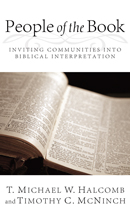It is with thanks to the kind folks at Wipf & Stock that I had a chance to read and review Michael Halcomb and his friend Timothy McNinich co-authored work People of the Book: Inviting Communities Into Biblical Interpretation (Wipf & Stock, 2012).
 Michael is a PhD student at Asbury, I believe under Ben Witherington and blogs here. Timothy is a pastor in the Vineyard denomination.
Michael is a PhD student at Asbury, I believe under Ben Witherington and blogs here. Timothy is a pastor in the Vineyard denomination.
One of the many goals in Christian discipleship is to help people know God and to make him known. One of the primary ways we come to know God and make him known (along with prayer and participation in a community of faith) is in teaching folks how to read and study the Bible, the primary source of the Christians faith life and practice. A major barrier to all that is time. We live in a time crunched world. It can take a lot of time to learn to read and study the Bible in a profitable way that contributes to a person’s spiritual growth and development. Given the limits of time and resources (and the widespread demise of Sunday schools in churches) how is the church to go about educating folks in these matters?
Halcomb and McNinch provide a way! Their book People of the Book, provides the Pastor or church leader, even Bible study leader a way to help facilitate study of the Bible in short time segments (roughly 45 min to 1 hr). Their book provides principles necessary for good Bible study in a group setting. The strongest emphasis is the need to do Bible study in a group setting and rarely if ever in a solitary setting. Why? Because group Bible study or communal Bible study helps safe guard against wild misguided interpretations and applications or what they call appropriations of the Scriptures. When done together in a community setting, it is far more beneficial and fruitful for all involved, and it make the process easier.
The ultimate goal of “Inviting Communities into Biblical Interpretation” which is the subtitle of the book, is to promote interpretive integrity by studying in a community context and downplaying interpreting the Bible through a lens of individuality, something we in the West are prone to do. Remember, the Bible was written to whole communities of people and congregations, not to individuals. Though I&II Timothy and Titus were initially written to individual persons, they were then communicated to congregations. There are very few if any uses of the singular “you” in Paul’s letters for example. So it is important that as much as possible Bible study be done in a community context.
Halcomb and McNinch discuss six movements in the process of studying a passage or book of the Bible. The process they present is much like the Inductive method but has some slight nuances and the biggest one is that it be done in a communal context meaning in a group together where perhaps pairs of people work on different movements at the same time then have the things learned be shared together so all can see and learn from one another.
The first movement is observation (20). Observation involves looking at the text (any set of verses being studied) and seeing what can be observed about a text at the surface level by asking lots of questions of the text (the primary path to understanding). The main way to do this is by way of recurrance ( finding repeated words, phrases, concepts, in the text). This helps really get at the details and specifics so you can know what the text says. You might do this by asking the who, what, when, where, how kinds of questions.
Once that is done and recorded, the next step is interpretive synthesis (27). This involves a “communal interpretive conversation” where “some hypotheses about what the author of the text was trying to communicate to his original audience utilizing our own best insights and the studied interpretations of biblical scholars. The goal is to come up with a shared synthesis of meaning (27).” Like working a puzzle you work the edges then work the pieces until it forms a picture, observation might be working the frame of the puzzle, interpretive synthesis could be putting the pieces together, together. 🙂 One area of difference Halcomb and McNinch have from what is typically taught is that in the search for meaning doesn’t involve looking for supposed “timeless truths” or in asking the question “what does this mean to me?” kinds of things. Instead, in pursuing interpretive synthesis the goal is simply to determine the meaning of the text as it stands, the best we can figure in its original context and setting. The whole “what it means to me?” issue comes in a later movement. It’s the same basic approach to when one is determining meaning in various kinds of literature. The main difference however lies in what we do with that meaning, how we let it influence us that differentiates between studying the Bible and studying other literature (29).
The next movement is to look at the ancient implications. What would it have looked like in the time of writing? It seeks to respect the intentions of the writers and seeks to know what they wanted folks to hear through their writings. It overlaps with interpretive synthesis and helps in transitioning to the fourth movement – appropriations.
Appropriations is working to bridge the gap between the past and the present. For Halcomb and McNinch appropriation is different than the typical “application” element of Inductive Bible Study. Appropriating involves determining “which realities of God’s nature and character do our biblical authors bear witness?” (39). So, after having made some observations to ask questions of the text and making an interpretive synthesis, appropriation ask, “so what do we learn about God from all this?” What does this passage. text, book, teach us about God’s character, ways, or reality?
After appropriations there is modern implications. Modern implications involves bringing the implications from the past forward into our own contexts. But that can only be done after you “bridge the gap” between past and future with appropriations. This is finally when you can ask the question “what does it mean for us today?”
Once we consider the modern implications the final movement in communal biblical interpretation is devotion. This is the ultimate goal of all Bible study – personal and corporate transformation that leads to greater levels of devotion. It is also what separates it from mere academic exercise and makes it an act of worship, and hence why they do not call it “application.” Devotion is meant to capture “the whole-life whole-community response to the God of the Bible” (45).
This is a great book and if you want to know more about these things and what they say about it all you will need to get it! Following the lay out of the movement for communal biblical interpretation the authors follow up with four different case studies where the reader can see how it all works in varying contexts from a home Bible study to a church service, to a cross-cultural setting (I remember Mike sharing about going on this trip). There is a final chapter on tips for facilitators and how to go about leading such groups and getting something like this going.
If it has made you tired just looking at all this, thinking man that’s a lot of work and there are only so many hours in a day. Well, it isn’t that much work as it takes everyone to get it done, there is little actual prep time since the work is being done as a group and different folks do different parts of the study, all the facilitator has to do is keep things moving along!
I think Mike and Tim have done a great job with this book and that those brave pastors and or church leaders who are willing to relinquish control over the direction of the study and allow a communal interpretive approach ought to go for it!
